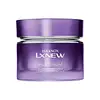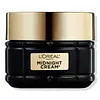What's inside
What's inside
 Key Ingredients
Key Ingredients

 Benefits
Benefits

 Concerns
Concerns

 Ingredients Side-by-side
Ingredients Side-by-side

Water
Skin ConditioningGlycerin
HumectantButylene Glycol
HumectantCaprylic/Capric Triglyceride
MaskingCyclopentasiloxane
EmollientHydrogenated Polydecene
EmollientNeopentyl Glycol Dicaprate
EmollientC14-22 Alcohols
Emulsion StabilisingDimethicone
EmollientPentaerythrityl Tetraethylhexanoate
EmollientGlyceryl Stearate
EmollientButyrospermum Parkii Butter
Skin Conditioning1,2-Hexanediol
Skin ConditioningBetaine
HumectantPEG-100 Stearate
C12-20 Alkyl Glucoside
EmulsifyingPanthenol
Skin ConditioningSilica
AbrasiveAmmonium Acryloyldimethyltaurate/Vp Copolymer
Polyacrylate-13
Parfum
MaskingAcrylates/C10-30 Alkyl Acrylate Crosspolymer
Emulsion StabilisingTromethamine
BufferingBeheneth-20
EmulsifyingStearyl Glycyrrhetinate
Skin ConditioningPolyisobutene
CI 77891
Cosmetic ColorantMica
Cosmetic ColorantCedrol
EmollientMadecassoside
AntioxidantCoco-Caprylate/Caprate
EmollientAdenosine
Skin ConditioningCetearyl Alcohol
EmollientArachidyl Alcohol
EmollientSqualane
EmollientTrisodium EDTA
CI 77491
Cosmetic ColorantPolysorbate 20
EmulsifyingPhytosteryl/Isostearyl/Cetyl/Stearyl/Behenyl Dimer Dilinoleate
Skin ConditioningBehenyl Alcohol
EmollientSorbitan Isostearate
EmulsifyingPalmitoyl Glycine
CleansingArachidyl Glucoside
EmulsifyingHydrogenated Lecithin
EmulsifyingMagnolia Obovata Bark Extract
Skin ConditioningCeramide NP
Skin ConditioningAdansonia Digitata Fruit Extract
EmollientHibiscus Sabdariffa Flower Extract
Skin ConditioningCholesterol
EmollientStearic Acid
CleansingCarbomer
Emulsion StabilisingGlucose
HumectantXanthan Gum
EmulsifyingWater, Glycerin, Butylene Glycol, Caprylic/Capric Triglyceride, Cyclopentasiloxane, Hydrogenated Polydecene, Neopentyl Glycol Dicaprate, C14-22 Alcohols, Dimethicone, Pentaerythrityl Tetraethylhexanoate, Glyceryl Stearate, Butyrospermum Parkii Butter, 1,2-Hexanediol, Betaine, PEG-100 Stearate, C12-20 Alkyl Glucoside, Panthenol, Silica, Ammonium Acryloyldimethyltaurate/Vp Copolymer, Polyacrylate-13, Parfum, Acrylates/C10-30 Alkyl Acrylate Crosspolymer, Tromethamine, Beheneth-20, Stearyl Glycyrrhetinate, Polyisobutene, CI 77891, Mica, Cedrol, Madecassoside, Coco-Caprylate/Caprate, Adenosine, Cetearyl Alcohol, Arachidyl Alcohol, Squalane, Trisodium EDTA, CI 77491, Polysorbate 20, Phytosteryl/Isostearyl/Cetyl/Stearyl/Behenyl Dimer Dilinoleate, Behenyl Alcohol, Sorbitan Isostearate, Palmitoyl Glycine, Arachidyl Glucoside, Hydrogenated Lecithin, Magnolia Obovata Bark Extract, Ceramide NP, Adansonia Digitata Fruit Extract, Hibiscus Sabdariffa Flower Extract, Cholesterol, Stearic Acid, Carbomer, Glucose, Xanthan Gum
Water
Skin ConditioningGlycerin
HumectantHydrogenated Polyisobutene
EmollientDimethicone
EmollientButylene Glycol
HumectantBis-Behenyl/Isostearyl/Phytosteryl Dimer Dilinoleyl Dimer Dilinoleate
EmollientButyrospermum Parkii Butter
Skin ConditioningLimnanthes Alba Seed Oil
Skin ConditioningStearyl Alcohol
EmollientC30-45 Alkyl Dimethicone
Skin ConditioningPEG-20 Stearate
EmulsifyingSaccharomyces/Xylinum/Black Tea Ferment
Skin ConditioningPanthenol
Skin ConditioningSilica
AbrasiveAdenosine
Skin ConditioningCapryloyl Salicylic Acid
ExfoliatingHydroxyacetophenone
AntioxidantHydroxypropyl Tetrahydropyrantriol
Skin ConditioningNeohesperidin Dihydrochalcone
MaskingPentaerythrityl Tetra-Di-T-Butyl Hydroxyhydrocinnamate
AntioxidantPotassium Hydroxide
BufferingTetrasodium Glutamate Diacetate
Tocopherol
AntioxidantOctyldodecanol
EmollientAcrylates/C10-30 Alkyl Acrylate Crosspolymer
Emulsion StabilisingAmmonium Polyacryloyldimethyl Taurate
Emulsion StabilisingCaprylyl Glycol
EmollientCarbomer
Emulsion StabilisingCitric Acid
BufferingGlyceryl Stearate
EmollientPEG-100 Stearate
PEG-30 Dipolyhydroxystearate
EmulsifyingPropylene Glycol
HumectantTrideceth-6
EmulsifyingAlpha-Isomethyl Ionone
PerfumingBenzyl Alcohol
PerfumingBenzyl Salicylate
PerfumingCitronellol
PerfumingGeraniol
PerfumingHexyl Cinnamal
PerfumingHydroxycitronellal
PerfumingLimonene
PerfumingLinalool
PerfumingCI 14700
Cosmetic ColorantCI 19140
Cosmetic ColorantChlorphenesin
AntimicrobialPotassium Sorbate
PreservativeSodium Benzoate
MaskingParfum
MaskingWater, Glycerin, Hydrogenated Polyisobutene, Dimethicone, Butylene Glycol, Bis-Behenyl/Isostearyl/Phytosteryl Dimer Dilinoleyl Dimer Dilinoleate, Butyrospermum Parkii Butter, Limnanthes Alba Seed Oil, Stearyl Alcohol, C30-45 Alkyl Dimethicone, PEG-20 Stearate, Saccharomyces/Xylinum/Black Tea Ferment, Panthenol, Silica, Adenosine, Capryloyl Salicylic Acid, Hydroxyacetophenone, Hydroxypropyl Tetrahydropyrantriol, Neohesperidin Dihydrochalcone, Pentaerythrityl Tetra-Di-T-Butyl Hydroxyhydrocinnamate, Potassium Hydroxide, Tetrasodium Glutamate Diacetate, Tocopherol, Octyldodecanol, Acrylates/C10-30 Alkyl Acrylate Crosspolymer, Ammonium Polyacryloyldimethyl Taurate, Caprylyl Glycol, Carbomer, Citric Acid, Glyceryl Stearate, PEG-100 Stearate, PEG-30 Dipolyhydroxystearate, Propylene Glycol, Trideceth-6, Alpha-Isomethyl Ionone, Benzyl Alcohol, Benzyl Salicylate, Citronellol, Geraniol, Hexyl Cinnamal, Hydroxycitronellal, Limonene, Linalool, CI 14700, CI 19140, Chlorphenesin, Potassium Sorbate, Sodium Benzoate, Parfum
 Reviews
Reviews

Ingredients Explained
These ingredients are found in both products.
Ingredients higher up in an ingredient list are typically present in a larger amount.
Acrylates/C10-30 Alkyl Acrylate Crosspolymer is a synthetic polymer. It is used to thicken and improve the texture of products. Due to its properties, it can prevent water and oil ingredients from separating.
Adenosine is in every living organism. It is one of four components in nucleic acids that helps store our DNA.
Adenosine has many benefits when used. These benefits include hydrating the skin, smoothing skin, and reducing wrinkles. Once applied, adenosine increases collagen production. It also helps with improving firmness and tissue repair.
Studies have found adenosine may also help with wound healing.
In skincare products, Adenosine is usually derived from yeast.
Learn more about AdenosineButylene Glycol (or BG) is used within cosmetic products for a few different reasons:
Overall, Butylene Glycol is a safe and well-rounded ingredient that works well with other ingredients.
Though this ingredient works well with most skin types, some people with sensitive skin may experience a reaction such as allergic rashes, closed comedones, or itchiness.
Learn more about Butylene GlycolThis ingredient is also known as shea butter. It is an effective skin hydrator and emollient.
Emollients help soothe and soften your skin. It does this by creating a protective film on your skin. This barrier helps trap moisture and keeps your skin hydrated. Emollients may be effective at treating dry or itchy skin.
Shea butter is rich in antioxidants. Antioxidants help fight free-radicals, or molecules that may harm the body. It is also full of fatty acids including stearic acid and linoleic acid. These acids help replenish the skin and keep skin moisturized.
While Shea Butter has an SPF rating of about 3-4, it is not a sunscreen replacement.
Shea butter may not be fungal acne safe. We recommend speaking with a professional if you have any concerns.
Learn more about Butyrospermum Parkii ButterCarbomer is a polymer of acrylic acid. Its main role is to create a gel consistency.
A high amount of carbomer can cause pilling or balling up of products. Don't worry, most products contain 1% or less of carbomer.
Dimethicone is a type of synthetic silicone created from natural materials such as quartz.
What it does:
Dimethicone comes in different viscosities:
Depending on the viscosity, dimethicone has different properties.
Ingredients lists don't always show which type is used, so we recommend reaching out to the brand if you have questions about the viscosity.
This ingredient is unlikely to cause irritation because it does not get absorbed into skin. However, people with silicone allergies should be careful about using this ingredient.
Note: Dimethicone may contribute to pilling. This is because it is not oil or water soluble, so pilling may occur when layered with products. When mixed with heavy oils in a formula, the outcome is also quite greasy.
Learn more about DimethiconeGlycerin is already naturally found in your skin. It helps moisturize and protect your skin.
A study from 2016 found glycerin to be more effective as a humectant than AHAs and hyaluronic acid.
As a humectant, it helps the skin stay hydrated by pulling moisture to your skin. The low molecular weight of glycerin allows it to pull moisture into the deeper layers of your skin.
Hydrated skin improves your skin barrier; Your skin barrier helps protect against irritants and bacteria.
Glycerin has also been found to have antimicrobial and antiviral properties. Due to these properties, glycerin is often used in wound and burn treatments.
In cosmetics, glycerin is usually derived from plants such as soybean or palm. However, it can also be sourced from animals, such as tallow or animal fat.
This ingredient is organic, colorless, odorless, and non-toxic.
Glycerin is the name for this ingredient in American English. British English uses Glycerol/Glycerine.
Learn more about GlycerinGlyceryl Stearate is a mix of glycerin and stearic acid.
It is used to stabilize the mixing of water and oil ingredients. By preventing these ingredients from separating, it can help elongate shelf life. It can also help thicken the product's texture.
As an emollient, it helps soften skin and supports barrier-replenishing ingredients.
In cosmetics, Glyceryl Stearate is often made from vegetable oils or synthetically produced.
This ingredient may not be fungal-acne safe
Fun fact: The human body also creates Glyceryl Stearate naturally.
Learn more about Glyceryl StearatePanthenol is a common ingredient that helps hydrate and soothe the skin. It is found naturally in our skin and hair.
There are two forms of panthenol: D and L.
D-panthenol is also known as dexpanthenol. Most cosmetics use dexpanthenol or a mixture of D and L-panthenol.
Panthenol is famous due to its ability to go deeper into the skin's layers. Using this ingredient has numerous pros (and no cons):
Like hyaluronic acid, panthenol is a humectant. Humectants are able to bind and hold large amounts of water to keep skin hydrated.
This ingredient works well for wound healing. It works by increasing tissue in the wound and helps close open wounds.
Once oxidized, panthenol converts to pantothenic acid. Panthothenic acid is found in all living cells.
This ingredient is also referred to as pro-vitamin B5.
Learn more about PanthenolParfum is a catch-all term for an ingredient or more that is used to give a scent to products.
Also called "fragrance", this ingredient can be a blend of hundreds of chemicals or plant oils. This means every product with "fragrance" or "parfum" in the ingredients list is a different mixture.
For instance, Habanolide is a proprietary trade name for a specific aroma chemical. When used as a fragrance ingredient in cosmetics, most aroma chemicals fall under the broad labeling category of “FRAGRANCE” or “PARFUM” according to EU and US regulations.
The term 'parfum' or 'fragrance' is not regulated in many countries. In many cases, it is up to the brand to define this term.
For instance, many brands choose to label themselves as "fragrance-free" because they are not using synthetic fragrances. However, their products may still contain ingredients such as essential oils that are considered a fragrance by INCI standards.
One example is Calendula flower extract. Calendula is an essential oil that still imparts a scent or 'fragrance'.
Depending on the blend, the ingredients in the mixture can cause allergies and sensitivities on the skin. Some ingredients that are known EU allergens include linalool and citronellol.
Parfum can also be used to mask or cover an unpleasant scent.
The bottom line is: not all fragrances/parfum/ingredients are created equally. If you are worried about fragrances, we recommend taking a closer look at an ingredient. And of course, we always recommend speaking with a professional.
Learn more about ParfumPeg-100 Stearate is an emollient and emulsifier. As an emollient, it helps keep skin soft by trapping moisture in. On the other hand, emulsifiers help prevent oil and water from separating in a product.
PEGS are a hydrophilic polyether compound . There are 100 ethylene oxide monomers in Peg-100 Stearate. Peg-100 Stearate is polyethylene glycol ester of stearic acid.
Silica, also known as silicon dioxide, is a naturally occurring mineral. It is used as a fine, spherical, and porous powder in cosmetics.
Though it has exfoliant properties, the function of silica varies depending on the product.
The unique structure of silica enhances the spreadability and adds smoothness, making it a great texture enhancer.
It is also used as an active carrier, emulsifier, and mattifier due to its ability to absorb excess oil.
In some products, tiny microneedles called spicules are made from silica or hydrolyzed sponge. When you rub them in, they lightly polish away dead skin layers and enhance the penetration of active ingredients.
Learn more about SilicaWater. It's the most common cosmetic ingredient of all. You'll usually see it at the top of ingredient lists, meaning that it makes up the largest part of the product.
So why is it so popular? Water most often acts as a solvent - this means that it helps dissolve other ingredients into the formulation.
You'll also recognize water as that liquid we all need to stay alive. If you see this, drink a glass of water. Stay hydrated!
Learn more about Water